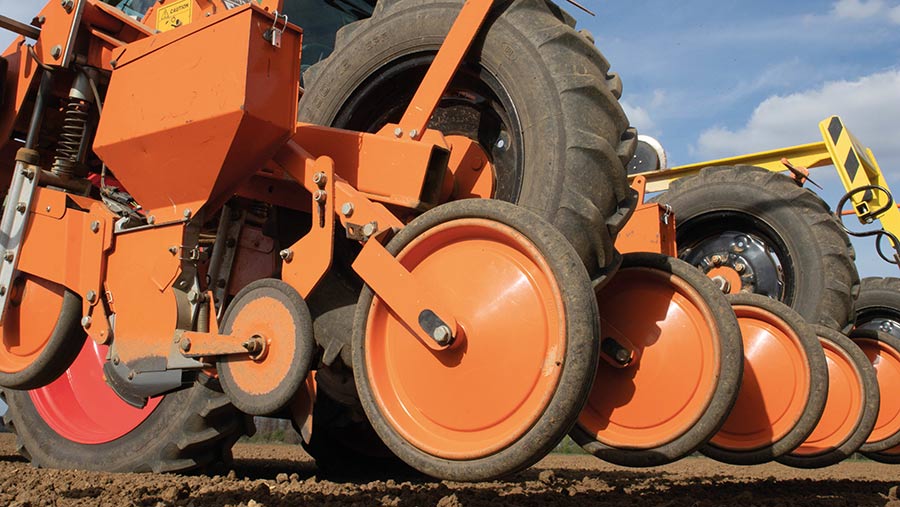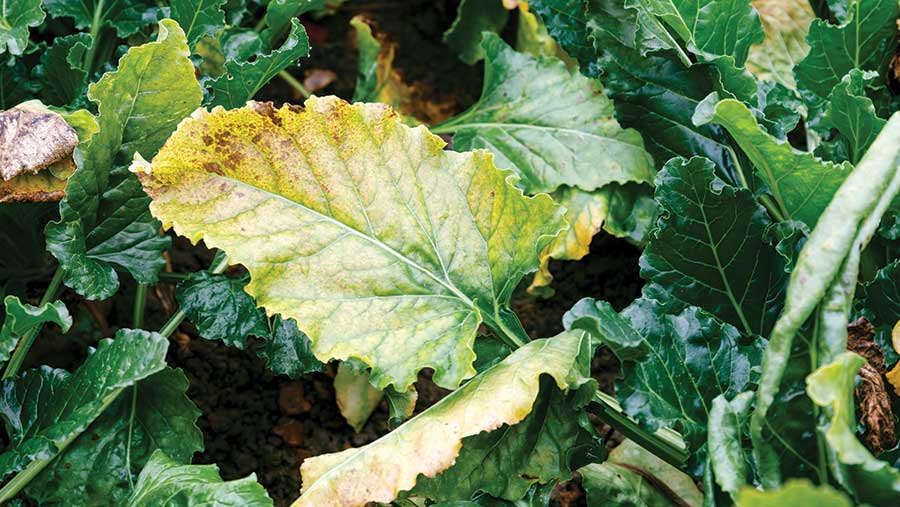How the emergency authorisation for neonics in beet will work
 © Tim Scrivener
© Tim Scrivener Sugar beet growers will potentially have the neonicotinoid seed treatment Cruiser SB available for use to control aphids transmitting virus yellows, which decimated yields last season, after Defra authorised an emergency approval for the 2021 season.
But the approval comes with restrictions and conditions. It can only being applied to seed if a Rothamsted model forecasts that the area likely to be infected with virus yellows will be above 9%, something that won’t be known until mid-February.
Simon Bowen, the British Beet Research Organisation’s (BBRO) head of knowledge exchange, says the forecasting model is primarily temperature-based. It takes into consideration weather patterns over winter in relation to crop drilling dates, as well as aphid population dynamics and virus content, to estimate likely infection levels.
See also: How to grow a better spring malting barley crop
The model has been shown to be accurate historically, with little difference between regions, and correctly predicted the high level of virus in 2020 in crops where no control measures were used, he says.
“January and February temperatures have more influence than earlier periods of time,” he says. “A continuous period of below-average day and night temperatures in January and/or early February, to drop the overall average temperature, would be needed for the need for treatment not to be triggered.”
Choice of treatments
Assuming the forecast is triggered, growers will have the choice of whether to use Cruiser SB-treated seed, which will then also be treated with Vibrance SB and Force ST, or have seed treated with Vibrance SB or both Vibrance SB and Force ST.
Vibrance SB provides protection against sugar beet seedling diseases, while Force ST controls soil pests such as springtails, symphylids and millipedes.
“If the virus yellows forecast threshold is triggered, there will be some growers who for rotational and following crop restriction reasons, as well as those simply not wanting to use a neonic, may choose not to have their seed treated,” Dr Bowen says.
“Growers may have to consider changing rotations to accommodate the restrictions. However, I don’t believe there will a significant area untreated with Cruiser SB if the derogation is triggered.”
British Sugar is asking growers to send revised seed orders detailing how to treat ordered varieties by 20 January. The seed of two varieties, Eldorana and Catriona, has already been prepared and is unavailable to be treated with Cruiser SB.
Non-neonic-treated sugar beet will be delivered first, and should be sent out in February, a letter to growers says. Only non-neonic-treated seed can be guaranteed to be delivered before March.
Cruiser SB-treated seed will be delivered from the last week of February through to the third week of March, with low-bolting varieties likely to be delivered first.
Dr Bowen says priority to confirm use of the neonic seed treatment will be given to growers who had already ordered seed, but it is expected there will be opportunities for additional beet area, allowing growers who had previously decided to reduce their area or not grow the crop, to potentially change their minds.
Lower rate
Approval for Cruiser SB is at a reduced rate of 45g of the active a unit (1 unit = 100,000 seeds), compared with 60g a unit previously used, he adds. “Trials demonstrate effective control 10 weeks after drilling, but the period of protection may be slightly shorter than achieved at the higher rate.
A follow-up aphicide may be required if the threshold of one green wingless aphid to four plants up to the 12-leaf stage of the crop is reached.”
Alongside the threshold-dependent use and reduced treatment rate, other conditions and restrictions apply to Cruiser SB, including for following crops, where only cereals, including maize and cereal-only cover crops, can be sown in the same field for the 22 months following the sowing of Cruiser SB treated sugar beet seed.
The restriction is from the drilling date of the beet crop rather than harvest date, Dr Bowen says.
In the 23rd month after sowing, any crop except oilseed rape and cover crops including oilseed rape can be sown, while oilseed rape must not be sown for a minimum of 32 months.

© Blackthorn Arable
Assuming beet crops are drilled in March or April 2021, that means the following crop in year one will be a cereal, most likely either winter wheat for earlier lifted crops or spring barley for later lifted beet. In year two, autumn planted crops in 2022 must also be cereals, with all other crops excluding oilseed rape not able to be planted before the spring of 2023.
Any grower looking to plant a spring crop in 2023 would not be able to grow a cover crop containing anything other than cereals over the previous autumn and winter.
With a minimum of 32 months before oilseed rape, in practice, the earliest that winter oilseed rape can be grown, following beet in 2021, will be autumn 2024 – as the first month it can be sown in after March-drilled neonic-treated beet will be November 2023, which is obviously past the sowing window for that autumn.
Restrictions on following crops after neonic-treated sugar beet |
|||
|
|
Non-restricted |
Restricted |
Extended restriction |
|
Rules |
No restrictions following sugar beet |
A minimum of 22 months from drilling of sugar beet |
A minimum of 32 months from drilling of sugar beet |
|
Crops |
All cereals including wheat, barley, maize, oats, rye, triticale and millet Cereal-only cover crops |
All other crops excluding oilseed rape Cover crops excluding oilseed rape |
Oilseed rape |
The restrictions are in place to minimise the risks from the persistence and mobility of neonicotinoids in soils that could result in residues with the potential to cause unacceptable effects to bees in following crops.
A similar measure is in place with a requirement to use an industry-recommended herbicide programme to minimise the number of flowering weeds in treated sugar beet crops, which again potentially could be a risk to bees.
“We will also be reminding growers that it will be crucial to focus on early, pre-flowering management of bolters,” Dr Bowen says.
In assessing the application, a Defra statement said the secretary of state was satisfied that there was sufficient evidence to indicate that residues of thiamethoxam and its metabolites deteriorate over time, and with these mitigation measures in place the risks were acceptably low enough that the benefits outweigh them.
Other restrictions
Other restrictions in place include a requirement that growers follow recommended seed rates to establish optimal populations and do not use excessively high seed rates.
But there are no buffer zone requirements for field margins and/or watercourses where the seed treatment is used, Dr Bowen says.
BBRO, in conjunction with NFU and British Sugar, is in the process of finalising the stewardship arrangements which will monitor residues in soils and plants through a targeted programme of testing.
Dr Bowen also suggests that BBRO and British Sugar collaborations with organisations involved in water catchment partnerships should allow research opportunities where there are knowledge gaps.
The emergency derogation, which has also been granted in many EU countries, is just one part of the industry’s efforts to reduce virus yellows, Dr Bowen stresses. “BBRO will shortly be releasing a five-point integrated plan to guide growers through the first few weeks of crop establishment.”
In addition, the multi-strand research programme to control virus yellows will continue to be prioritised, including the development of resistant plant varieties, investigating the effects of undersown cover crops, flowering mixes boosting beneficial predators, companion crops and endophyte grasses, which might boost natural resistance in sugar beet.
Active Ingredients
Cruiser SB thiamethoxam
Vibrance SB sedaxane + fludioxonil + metalaxyl-M
Force ST tefluthrin

